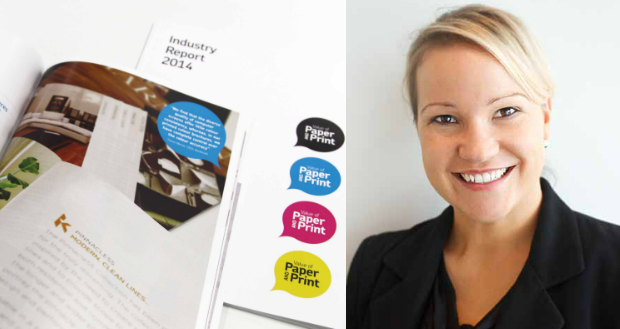
Marketers and media buyers have the luxury of choice with media options today. From traditional channels such as television, radio and of course print, to newer and emerging channels such as the internet, digital and augmented reality technologies – the options, it could be argued, are only limited by imagination.
Yet which channel mix promises the Holy Grail of consumer response? Which is the most effective and efficient combination? How do we balance all the benefits of each media channel to create the ultimate multi-channel campaign? Which mix delivers the highest sales outcome with the best ROMI results? And most importantly what role will print play in the future? With the launch of the Value of Paper and Print, the print industry’s effectiveness campaign, let’s touch on the role of print in today’s world and how print delivers innovation.
Printers are often asked is print innovative? What technologies can it adopt to keep current in the digital age? How will print evolve to remain relevant? Loaded questions which unfortunately the print industry has felt compelled to answer.
Innovation is not determined by how the innovative idea is applied. Innovation comes from the idea itself. A campaign encouraging children of abuse to report their abusers saw a series of billboards printed delivering two different messages at the same time using lenticular innovation. The adult version was a standard anti-child abuse billboard and yet when viewed by a child the message was to call the hotline number if abuse is happening to you. Newspapers infused with baby powder, malaria medication, or direct mail pieces infused with catnip to promote cat litter. All innovation, all paper based and none digital.
The answer is not one or the other. Us against them. Digital versus physical. Rather it is a much-needed understanding of how each interrelates, connects and engages the audience and ultimately your customer. Each channel has its own strengths and weaknesses – digital is instant where print holds a longer attention period. Television is interruptive and socially engaging whereas magazines are selected and scrutinised.
Print, being a more traditional media, has needed to reflect on some criticism over recent years with some sensational headlines – the paperless office, print is dead, print is extinct and the like. Yet the commercial print industry remains one of the largest industries in the country generating sales of $7.5bn annually. It employs more than 320,000 Australians, delivers a $2bn catalogue industry and has more than 15 million people reading newspapers every month. As a country we spend $790m a year on magazines, one of the highest per capita across the globe. Print remains a strong and robust industry, and unquestionably has the widest reach of any channel.
While perhaps not the newest toy in the room, paper and print are consistently proving one of the strongest performers.
The figures are impressive, yet the humble nature of the paper and print industries has perhaps incorrectly seen the channel overlooked.
This Value of Paper and Print Industry report delivers a comprehensive overview with a collection of industry data, national and international research, trends and inspiring ideas representing the media channel of today.
It is a tool to inform and educate on the strong ROI figures – (290 per cent catalogues, 130 per cent magazines and 120 per cent newspapers). Case studies, statistics and innovative applications of paper and print provide this opportunity for the industry to show its strengths whether standalone or complementary as part of a strong multi-channel campaign.
With paper and print the complete spectrum of our senses is explored. Whoever would have thought a supermarket could educate children on how fresh herbs, fruits and vegetables smell and feel? Woolworths’ and Jamie Oliver’s collaboration to develop Jamie’s Garden Sticker Album saw a remarkable paper and print based campaign, aimed at educating Australian children about the origins and health benefits of fresh fruit and vegetables.
Stickers were printed with the senses in mind, the herb range released stickers smelling of sage, rosemary and parsley. Heat sensitive stickers encouraged children to rub away the dirt and see how carrots and potatoes grow. Textured printing allowed children to feel how eggs felt fresh from the farm.
In Europe an anti-cancer campaign saw the magazine cover treated with heat-sensitive inks that allowed it to turn red when placed in direct sunlight and in turn raise awareness of sunburn and promote sun-care. Clever applications and case studies build inspiring anecdotes and food for thought for agencies and marketers looking to stand out in front of their customers.
The liquor company who included ‘standing out’ in their brief to their agency demanded a label design for their bottles that would be noticed within the noise and poor lighting within a night club. The solution, electroluminescent technology to create movement of light on the pack in a sequence of effects that highlight the brandmark with light pulsing through it like sound waves echoing the beat of music. When lined up in a bar they can be programmed into a sequence turning a row of bottles into a giant display screen through non-static labelling. Innovative, tick. Results, tick.
Mixing technologies within print adds to the power of print. A Japanese newspaper has developed an augmented reality app that changes articles for adults into features for children. The child-friendly version features simplified language and cartoon animation on all articles.
Similar integration saw confectionery bar Kit Kat create technology block outs when consumers read their advertisements in magazines. Their magazine adverts blocked people’s access to wi-fi and supported their positioning statement of ‘have a break’. The zones surrounding the Kit Kat magazine advertisements blocked people within a five metre radius, and encouraged people to enjoy an uninterrupted read of the magazine or book.
The VoPP campaign is an effectiveness campaign promoting the strengths of paper and print as a media channel, the report underpinning the entire campaign does not suggest print as the only media channel of merit, rather it is to educate on the important part print continues to play in delivering significant returns on marketing spend, to highlight its relevance in a landscape with a multitude of choices and to identify the positive contribution print provides as a partner with other channels.
Sharing innovation or innovative applications of print through campaigns with your clients not only inspires, but also places print where it should be – the first element added to any campaign. Go to the campaign website to inform yourself and others.
Brand Recall
Brand and marketing professionals evaluate markets through focus groups, market research, analysis, trend reporting and more to determine the best steps to engage their target audience. And rightly so; effective brand messaging delivers long lasting sales return.
Understanding how the human brain processes information from different mediums is crucial when developing tactical advertising and marketing campaigns that align to your brand. What role does science play in understanding how humans absorb, interact with and retain messages? And how does this influence humans when making the ultimate decision to align with, be loyal to, or purchase from companies? It used to be about good copywriting, now it is another level – paper, screen, smartphone.
Enticing customers to read the material, retain it, recall it and act upon it relies on an understanding of how the human brain imports and exports information and, more importantly, how the brain interprets written language. There have been innumerable studies undertaken over many decades regarding the retention and recall of information, in all its physical forms, across various age groups on both paper and on screen.
The core weight of evidence points consistently to the preference of ink on paper, as not only the preferred option over screens, but also the medium that delivers more depth of comprehension and recall.
Psychologists outline the differences between ‘recalling’ something and ‘knowing’ something. To recall something requires factual recitation and is retained for shorter periods of time. Knowing something is more personalised and emotive (Gardiner, 2001).
Aspirational and luxury brands such as Chanel, Ralph Lauren and Louis Vuitton, hold ‘knowingness’ connections with their customers and in turn demand brand loyalty, value and attachment. When achieving this, brands that understand how well customers absorb text may well be the strongest performers with the most loyal customers.
Brands communicating on paper open greater opportunity for customers to experience the brand, not simply consume the information being presented. A study conducted by Miratech, a leading French user-experience consultancy firm, explored how users interact with information and compared online versus paper readership. Detailed analysis, employing eye tracking technology, found that whilst there was no significant time difference in reading time, eyes do linger longer on paper (275ms) than on screen (231ms), showing people concentrate more when reading an actual newspaper article, for example, than when reading the same article onscreen.
Some 20 per cent of users remember an article better when reading it on paper. Not only does paper encourage more focused reading but also promotes higher retention.
Comment below to have your say on this story.
If you have a news story or tip-off, get in touch at editorial@sprinter.com.au.
Sign up to the Sprinter newsletter

